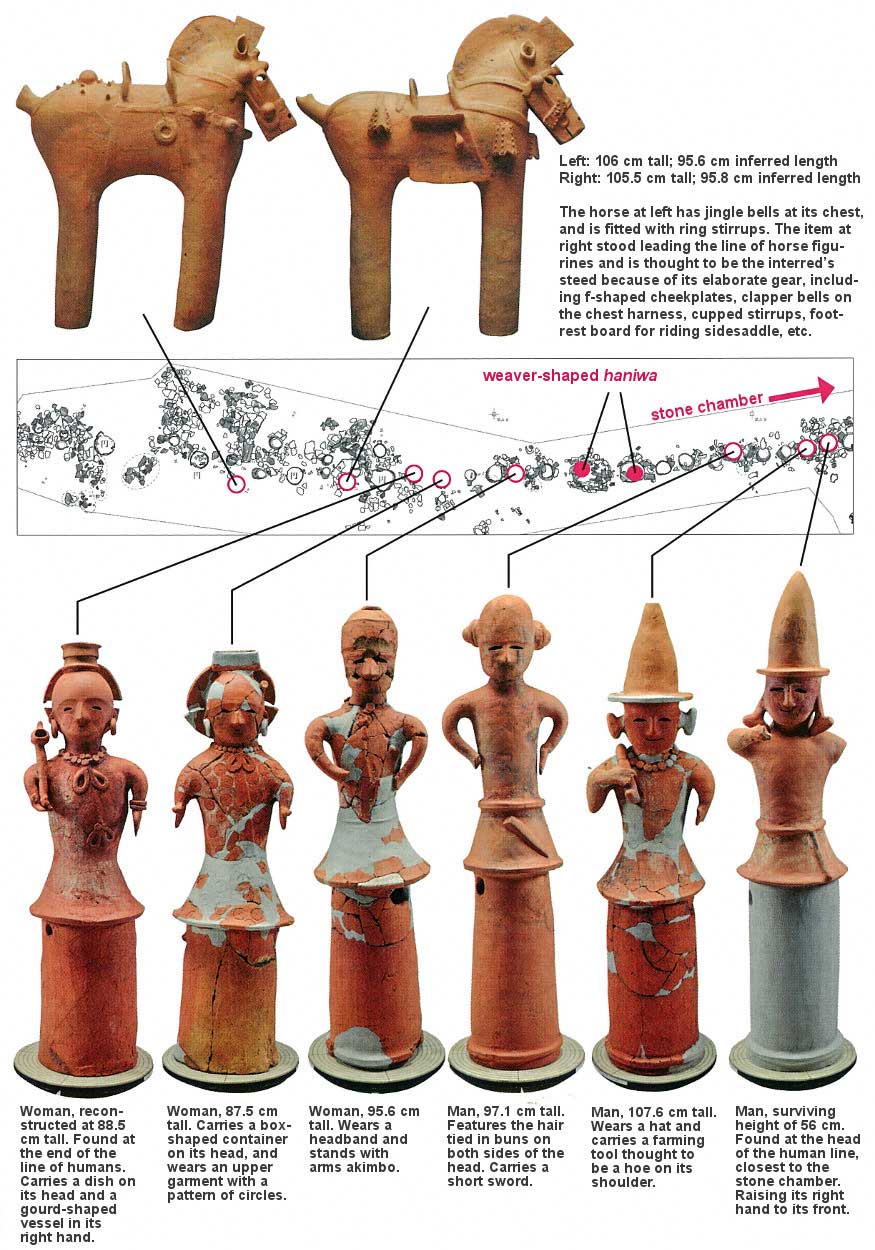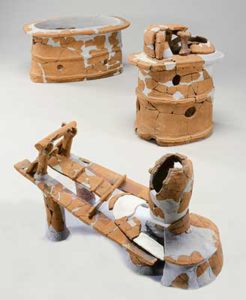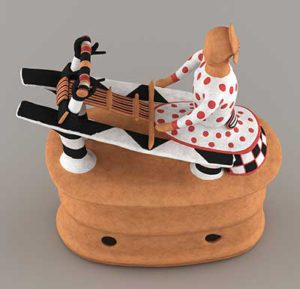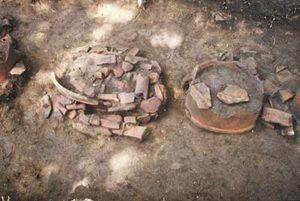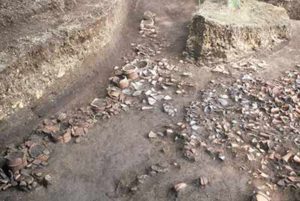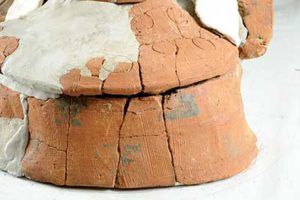Weaver-shaped haniwa
It is thought that the loom and woman (only the torso survives) at the front of the photo sat atop the stand at the back left. The length of the loom is 73.2 cm. The weaver-shaped haniwa at the back right is missing the human portion except for fragments of both arms, and the surviving height is 53.7 cm.
Reconstructed image of a weaver-shaped haniwa made with computer graphics technology
Weaver-shaped haniwa, in situ
These were placed near the center of the line of representational haniwa figurines, with their backs facing the stone chamber. The human portion of the haniwa at left in the photo has survived. From evidence they wore bracelets, the figures are thought to have been women.
Line of human haniwa and pottery group, in situ
The human figurines apart from the weaver-shaped haniwa were lined up facing the moat, and in front of them approximately 360 pieces of pottery were found.
Kabutozuka tomb
A scallop-shell-shaped keyhole mound approximately 80 m in overall length, the first tier has a broad terrace. The stone chamber is the horizontal type and made of volcanic tuff. The line of representational haniwa was uncovered on the western side, near the constricted joint of the round and angular portions of the mound, and starting from the items near the stone chamber, they were lined up in the order of: male human figurines → weaver-shaped haniwa → female human figurines → horse figurines.
Adapted from Hakkutsu sareta Nihon rettō 2015 [Excavations in the Japanese Archipelago, 2015] (Bunkachō [Agency for Cultural Affairs], ed., Kyodo News, 2015).
The haniwa painting comes vividly back to life through computer graphics technology
Residues of pigment
As a result of examining the pigment remaining on the representational haniwa, it became clear that the four colors of red, white, black, and gray were used. Of the weaver-shaped haniwa, the upper garment on the item with the surviving human portion was seen as fashioned with a design of red circles on a white base. Also, as traces of white color were detected on the body portions of all four horse figurines, they are thought to have been depictions of white horses.
Reconstructed model of a horse-shaped haniwa
Reconstructed image of a weaver-shaped haniwa (circled area is that of the photo at upper left)
Kabutozuka Tomb, Shimotsuke City, Tochigi Prefecture
Late Kofun period (latter half, sixth century)
A circularly arranged group of haniwa
The Kabutozuka tomb sits on a fertile tableland running alongside three rivers, located in the city of Shimotsuke in the southern portion of Tochigi prefecture. In this area, large-scale tombs were continuously built in the Late Kofun period (latter half of the sixth century) in a scallop shell shape unique to this region, known as the Shimotsuke-type tomb. Also, in the subsequent ritsuryō period (latter half of the seventh–tenth centuries), this area flourished as the nucleus of the ancient province of Shimotsuke, where the provincial headquarters, monastery, nunnery and so forth were constructed.
In recent years, when excavation was conducted in conjunction with preparations of the adjacent remains of the provincial monastery, Shimotsuke Kokubunji (a Historic Site), it was learned that the Kabutozuka tomb is a scallop-shell-shaped keyhole mound on a scale of 80 m in overall length, and from the recovered artifacts, that it was built in the Late Kofun period. Also, there is a terrace about 14 m wide on the tomb (atop the first tier), at the middle of which cylindrical haniwa were lined up single file encircling the mound. Further, on the western side of the mound, representational haniwa in the shapes of horses and humans were ascertained as having stood in the line. There were 24 figurines in all that could be reconstructed, and not only could their condition of alignment be confirmed, based on the pigment surviving in scant amounts on the recovered sherds, it was learned they were painted in the four colors of red, white, black, and gray.
The first weaver-shaped haniwa recovered nationwide
Of the 24 representational haniwa, two items were depictions of women weaving cloth. The recovery of such weaver-shaped haniwa is the first example for all of Japan. Also, as each gave form to a different type of loom, it is seen that there were already structurally differing looms by around the latter half of the sixth century.
While there are several theories as to the reason for placing groups of haniwa on tombs, in the case of the Kabutozuka tomb a large amount of pottery was recovered in front of the line of haniwa, and it is inferred that some kind of activity (perhaps ritual) was conducted in front of these items. Reasons for the recovery of weaver-shaped haniwa are unclear in the details, but in the ancient chronicle Kojiki there are descriptions of weaving on looms as a sacred act, and it may be said that perhaps the person interred at the Kabutozuka tomb carried out some role related to weaving. (Kimura Tomonori)
Haniwa in the shapes of humans and horses line up in a circle around the stone chamber
